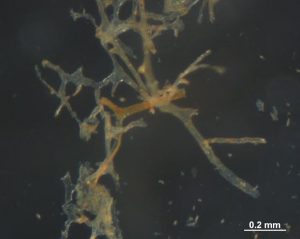
DNA might get all the attention, but proteins do the work. The recent confirmation that it is possible to extract proteins — which are encoded by DNA and perform all of the functions that keep living cells alive — from 80-million-year-old dinosaur bones has provided fodder for big questions about everything from evolution to biomaterials to extraterrestrial life.
Mary Schweitzer, PhD, professor of biology at North Carolina State University, will present her work on refining methods to extract and responsibly use dinosaur proteins at the American Association of Anatomists annual meeting during the Experimental Biology 2017 meeting, to be held April 22-26 in Chicago.
“When you think about it, it is the message of DNA — the proteins — that are actually the stuff on which natural selection works,” said Schweitzer. “The sequences of proteins can be used to generate ‘family trees’ of organisms, just like DNA. But modifications to proteins, which are not found in DNA and can’t be reliably predicted from DNA sequence alone, can tell us how a protein functioned, because the function of a protein is determined by its 3-D structure.”
For example, if you find a proline amino acid with an extra OH (oxygen + hydrogen) group attached, you can be almost certain you have collagen, the stuff that holds together skin and other connective tissues throughout the body. From the standpoint of function and evolutionary fitness, changes in DNA over time don’t really matter unless the protein changes; as a result, studying changes in proteins over time can yield richer information about evolution than studying DNA alone, Schweitzer explained.
Proteins also can yield clues about the age of a sample or about the environment in which an animal lived or was buried. Researchers are also keen to understand what makes some proteins break down while others persist for eons. Conveniently, Schweitzer and others have found that proteins (or at least some types of them) are more likely to remain stable over tens of millions of years than DNA is, making them low-hanging fruit for extracting new information from old bones.
Now that she and her colleagues have demonstrated repeatedly that proteins can be extracted from dino bones, Schweitzer is focusing on new research directions. First, she is turning her attention toward refining methods for studying these ancient proteins so that paleontologists can get more information with less damage to specimens. Mass spectrometry, central to her team’s current methods, is time-intensive and necessarily destroys the sample, so Schweitzer’s team is working to build a database of methods and criteria that other researchers might employ to get as much information as they can from other fossils and optimize the use of mass spectrometry when it is truly worthwhile. She also is working on ways to broaden the search for proteins to different dinosaur tissues, specimens and environments.
A second area of focus is to explore what, exactly, proteins can tell us about the organism that produced them. For example, can they reveal more about the animal’s physiology and not just evolutionary relationships? Can they tell us more about the functions, not only of proteins, but of the tissues they comprise? What about reproductive behavior? Or maybe proteins can be used to help pin down the timing of when various evolutionary novelties emerged at different points in Earth’s history.
Paleontologists, of course, are interested in what life was like in the era of the dinosaurs, but Schweitzer believes this research also can have implications for our own times and even our future. Given that the dinosaurs lived through numerous periods of global change, for example, perhaps we can learn something from how they responded to those shifts on a molecular level as we face our own global changes. In addition, understanding what makes some proteins break down quickly or persist indefinitely could help researchers identify exciting new opportunities in drug development or the development of biomaterials.
“We have transparent, flexible, hollow polymers that have lasted for 80 million years,” Schweitzer pointed out. “Someone surely can find a use for that!”
Refining the research methods used to extract proteins from ancient bones could even come in handy in the quest for extraterrestrial life, she noted. After all, sifting through bone buried in the sediments of Montana for infinitesimally small, fragmented biomolecules might not be so very different from sifting through the sediments of Mars for signs of life.
Note: The above post is reprinted from materials provided by Experimental Biology 2017.










